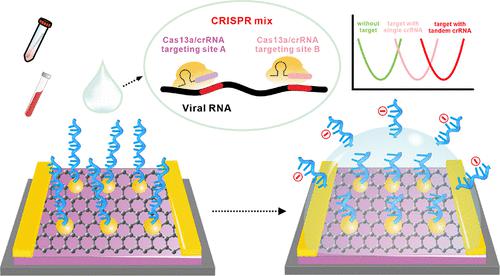Our official English website, www.x-mol.net, welcomes your
feedback! (Note: you will need to create a separate account there.)
Tandem Cas13a/crRNA-Mediated CRISPR-FET Biosensor: A One-for-All Check Station for Virus without Amplification
ACS Sensors ( IF 8.2 ) Pub Date : 2022-09-08 , DOI: 10.1021/acssensors.2c01200 Jiahao Li 1 , Lina Tang 1 , Tingxian Li 1 , Kun Li 1 , Yulin Zhang 1 , Wei Ni 2 , Meng-Meng Xiao 3 , Youyun Zhao 2 , Zhi-Yong Zhang 3 , Guo-Jun Zhang 1
ACS Sensors ( IF 8.2 ) Pub Date : 2022-09-08 , DOI: 10.1021/acssensors.2c01200 Jiahao Li 1 , Lina Tang 1 , Tingxian Li 1 , Kun Li 1 , Yulin Zhang 1 , Wei Ni 2 , Meng-Meng Xiao 3 , Youyun Zhao 2 , Zhi-Yong Zhang 3 , Guo-Jun Zhang 1
Affiliation

|
The path toward field-effect transistor (FET) application from laboratory to clinic has delivered a compelling push in the biomedical domain, yet ultrasensitive and timely pathogen identification without PCR remains a long-lasting challenge. Herein, we create a generic check station termed “CRISPR-FET”, first incorporating the CRISPR/Cas13a system within the FET modality, for accelerated and unamplified detection of viral RNA. Unlike conventional FETs bearing target-specific receptors, this sensor holds three unique advancements: (i) an ingenious sensing mechanism is used, which converts the signal of a large-sized analyte into an on-chip cleavage response of an immobilized CRISPR reporter, enabling signal generation events to occur all within the Debye length; (ii) the multipurpose inspection of the CoV ORF1ab, CoV N gene, and HCV RNA unveils the potential for “one-for-all” scalable FET-based molecular diagnostics; and (iii) it is shown that Cas13a-crRNAs targeting different sites of the viral genome can be deployed in tandem to amplify the FET response, empowering the detection limit down to 1.56 aM, which is a world-record level of sensitivity in the FET for direct viral gene sensing. Notably, a brilliant clinical applicability was made in distinguishing HCV-infected patients from normal controls. Overall, this study sheds new insights into FET-based nucleic acid sensing technology and invokes a vision for its possible future roles in diagnosis of various viral diseases.
中文翻译:

串联 Cas13a/crRNA 介导的 CRISPR-FET 生物传感器:无需扩增的一体式病毒检查站
从实验室到临床的场效应晶体管 (FET) 应用之路在生物医学领域取得了令人信服的推动力,但在没有 PCR 的情况下进行超灵敏和及时的病原体鉴定仍然是一项长期挑战。在此,我们创建了一个名为“CRISPR-FET”的通用检查站,首先将 CRISPR/Cas13a 系统整合到 FET 模态中,用于加速和非放大检测病毒 RNA。与带有目标特异性受体的传统 FET 不同,该传感器具有三个独特的进步:(i) 使用巧妙的传感机制,将大尺寸分析物的信号转换为固定化 CRISPR 报告基因的片上裂解反应,使信号生成事件全部发生在德拜长度内;(ii) CoV ORF1ab、CoV N 基因的多用途检查,HCV RNA 揭示了“一劳永逸”可扩展的基于 FET 的分子诊断的潜力;(iii) 结果表明,针对病毒基因组不同位点的 Cas13a-crRNA 可以串联部署以放大 FET 响应,使检测限低至 1.56 aM,这是 FET 的世界纪录灵敏度水平用于直接病毒基因检测。值得注意的是,在区分 HCV 感染患者和正常对照方面取得了出色的临床适用性。总的来说,这项研究为基于 FET 的核酸传感技术提供了新的见解,并为其未来在各种病毒性疾病诊断中可能发挥的作用提出了愿景。(iii) 结果表明,针对病毒基因组不同位点的 Cas13a-crRNA 可以串联部署以放大 FET 响应,使检测限低至 1.56 aM,这是 FET 的世界纪录灵敏度水平用于直接病毒基因检测。值得注意的是,在区分 HCV 感染患者和正常对照方面取得了出色的临床适用性。总的来说,这项研究为基于 FET 的核酸传感技术提供了新的见解,并为其未来在各种病毒性疾病诊断中可能发挥的作用提出了愿景。(iii) 结果表明,针对病毒基因组不同位点的 Cas13a-crRNA 可以串联部署以放大 FET 响应,使检测限低至 1.56 aM,这是 FET 的世界纪录灵敏度水平用于直接病毒基因检测。值得注意的是,在区分 HCV 感染患者和正常对照方面取得了出色的临床适用性。总的来说,这项研究为基于 FET 的核酸传感技术提供了新的见解,并为其未来在各种病毒性疾病诊断中可能发挥的作用提出了愿景。
更新日期:2022-09-08
中文翻译:

串联 Cas13a/crRNA 介导的 CRISPR-FET 生物传感器:无需扩增的一体式病毒检查站
从实验室到临床的场效应晶体管 (FET) 应用之路在生物医学领域取得了令人信服的推动力,但在没有 PCR 的情况下进行超灵敏和及时的病原体鉴定仍然是一项长期挑战。在此,我们创建了一个名为“CRISPR-FET”的通用检查站,首先将 CRISPR/Cas13a 系统整合到 FET 模态中,用于加速和非放大检测病毒 RNA。与带有目标特异性受体的传统 FET 不同,该传感器具有三个独特的进步:(i) 使用巧妙的传感机制,将大尺寸分析物的信号转换为固定化 CRISPR 报告基因的片上裂解反应,使信号生成事件全部发生在德拜长度内;(ii) CoV ORF1ab、CoV N 基因的多用途检查,HCV RNA 揭示了“一劳永逸”可扩展的基于 FET 的分子诊断的潜力;(iii) 结果表明,针对病毒基因组不同位点的 Cas13a-crRNA 可以串联部署以放大 FET 响应,使检测限低至 1.56 aM,这是 FET 的世界纪录灵敏度水平用于直接病毒基因检测。值得注意的是,在区分 HCV 感染患者和正常对照方面取得了出色的临床适用性。总的来说,这项研究为基于 FET 的核酸传感技术提供了新的见解,并为其未来在各种病毒性疾病诊断中可能发挥的作用提出了愿景。(iii) 结果表明,针对病毒基因组不同位点的 Cas13a-crRNA 可以串联部署以放大 FET 响应,使检测限低至 1.56 aM,这是 FET 的世界纪录灵敏度水平用于直接病毒基因检测。值得注意的是,在区分 HCV 感染患者和正常对照方面取得了出色的临床适用性。总的来说,这项研究为基于 FET 的核酸传感技术提供了新的见解,并为其未来在各种病毒性疾病诊断中可能发挥的作用提出了愿景。(iii) 结果表明,针对病毒基因组不同位点的 Cas13a-crRNA 可以串联部署以放大 FET 响应,使检测限低至 1.56 aM,这是 FET 的世界纪录灵敏度水平用于直接病毒基因检测。值得注意的是,在区分 HCV 感染患者和正常对照方面取得了出色的临床适用性。总的来说,这项研究为基于 FET 的核酸传感技术提供了新的见解,并为其未来在各种病毒性疾病诊断中可能发挥的作用提出了愿景。











































 京公网安备 11010802027423号
京公网安备 11010802027423号